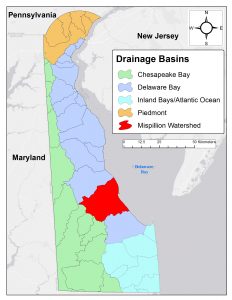
Facebook Twitter Instagram YouTube
Written on: March 14th, 2016 in Wetland Animals
BY Brittany Haywood, DNREC’s Wetland Monitoring and Assessment Program
Thanks to all that extra water lying around, all sorts of amphibians start to come alive this time of year in Delaware. Frogs and salamanders use these seasonal pools of water, or wetlands, to breed and can only do so because predatory fish cannot survive the lack of permanent water. They then use the surrounding drier wetlands and uplands as summer habitat.

In your travels you may have started to hear the sounds of the Spring Peeper. Their sound is a high pitched “peep peep peep” and when singing together it has been said, they sound like a chorus of bells. The Spring Peeper males use these sounds to attract a mate, and are one of the earliest breeding frogs you will find in the State. They are brown to grey in color and can be identified by an X-marking on the back.

Spotted, Marbled and Eastern Tiger Salamanders are just a few of the salamanders that roam the state. These salamanders are in the mole salamander family because they spend most of their adult life under leaves, logs or in holes or burrows in the ground. They only return to the water, such as that in vernal pools, to breed during the winter/spring months.

Written on: March 14th, 2016 in Wetland Assessments
By Brittany Haywood, DNREC’s Wetland Monitoring and Assessment Program

In the summer of 2012, DNREC’s Wetland Monitoring & Assessment Program rated the health of wetlands in the Mispillion and Cedar Creek River Watershed’s tidal and non-tidal flat and riverine wetlands. The goal of this project was to summarize recent gains and losses in wetland acreage, assess the condition, and identify impacts on the wetland. The watershed received an overall grade of C; broken down into tidal wetlands receiving a B-, non-tidal flat wetlands receiving a C+, and non-tidal riverine wetlands receiving a C-. This was the sixth watershed in Delaware to be assessed.
The Mispillion Watershed lost 20% of wetlands since the early 1700s, with the majority due to conversion of land to agricultural fields or developments and erosion from rising sea levels.

The three most common impacts to wetlands were the:
Presence of invasive plants (such as Phragmites) that can out grow native plant species
Ditching of wetlands to remove its ability to hold water
Agriculture or development just outside the wetland blocking its ability to migrate landward.
The full report, data and report card are now available online.
Written on: March 14th, 2016 in Education and Outreach
By Brittany Haywood, DNREC’s Wetland Monitoring and Assessment Program

Winter storms and nor-easters brought excess rainfall, rough seas, and unseasonably high tides to Delaware this winter, highlighting the value of nature’s first line of defense against coastal storms; wetlands. Up and down Delaware’s coast, roadways were made impassable due to rising seas, buildings were battered by winds and water, and dunes and boardwalks were washed away by angry waves.
But don’t’ fret, there is hope in minimizing the effects of storms on your property: Protect, Preserve and Restore Wetlands! Wetlands have the innate ability to store flood waters, buffer storm surges, and prevent erosion. Did you know that peak floods can be reduced up to 60% in watersheds that contain 15% wetlands(NOAA Digital Coast)?
There are multiple things you can do to protect and preserve wetlands: